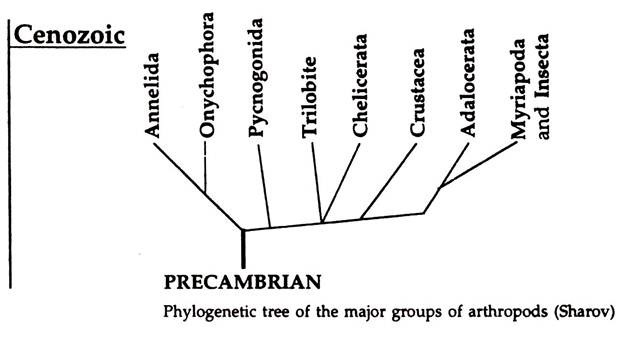In this article we will discuss about the evolutionary status of peripatus.
It is presumed that Onychophora represents a phylogenetically intermediate stage between Annelida and Arthropoda. However, some of their special adaptations do not confirm the “missing link” status of Onychophora, as suggested by some authors.
Kestner (1968) lists the following features in this regard:
1. Transformation of the claws of the 2nd and 3rd appendages into mandible.
ADVERTISEMENTS:
2. The number of tracheal spiracles and their disposition on the body.
3. Fine structures of the eye.
The importance of onychophores in tracing the phylogeny of arthropods has been discussed by Sharov (1966) and Manton (1973), who consider that arthropods are monophyletic and the onychophores represent an isolated line of evolution.
Peripatus was assigned different systematic position by zoologists. It was placed in Annelida by some while others thought it was Myriapoda, Mosely (1874).
ADVERTISEMENTS:
Marshall and William (1972) and Storer (1983) considered Peripatus as an aberrant form and placed it in a separate subphylum Onychophora under phylum– Arthropoda.
Tiegs and Manton (1958) and Manton (1970) believe the Arthropoda is polyphyletic and that the modern Onychophora, Myriapoda, Symphyla and Insecta have evolved from onychophore like ancestral stock.
Kaestner (1968) and Meglitsch (1972), Barnes (1980) considered Onychophora as an independent phylum.
ADVERTISEMENTS:
However, the Onychophora differs from other tracheae’s in the simplicity and diffuseness of tracheae; in having only one pair of jaws; in the absence of external segmentation; in the nature of body wall and the number of short rings bearing minute spines.
The ladder-like ventral nervous system is considered primitive for its resemblance to that of primitive molluscs, phyllopod crustaceans and nemertean’s. It is not certain that the antennae, jaws and oral papillae of Peripatus precisely correspond to the antennae, mandibles and first maxillae of insects.
It may be concluded that Peripatus is a survivor of archaic type, related to the Middle Cambrian marine fossil Aysheaia, ancestral to tracheate and closely related to annelids, might have been derived from the type of lobopod annelids by the loss of eversible proboscis and subsequent development of jaws. However, the Peripatus and its relatives may be placed in a separate phylum Onychophora.
